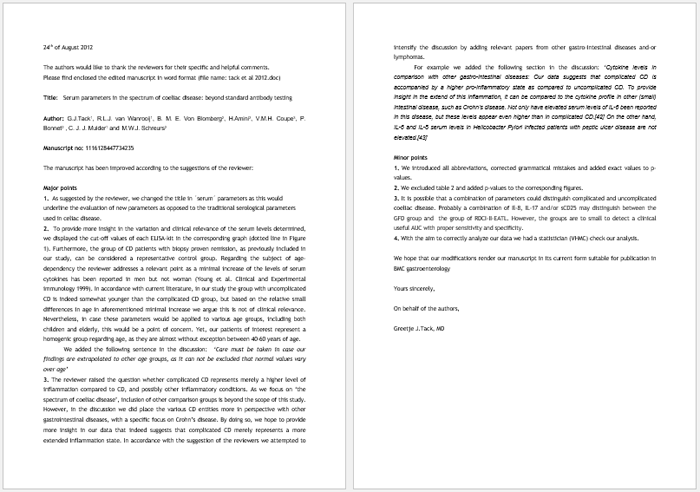Rebuttal letter (Guide & Sample Letters)
A rebuttal letter is a response to reviewers and editor’s comments after an author or researcher submit their work for publication. You will hardly find a manuscript that has been submitted for publishing with no suggested revisions.
Every journal or publication site has their set guidelines for publication. When an author submits their manuscript for publication, it goes through the hands of reviewers/editors to figure out if the author has adhered to submission guidelines and if their work is ready for publication. The letter will respond to the reviewer’s comments besides revising the manuscript.
You can also use the letter to counter false accusations, an appeal for performance evaluation report at work or in legal circles to counter false evidence.
Authors find challenges in writing such letters. If you’re in doubt on how to respond to reviewers’ comments, use templates and samples.

Things to keep in mind when writing a rebuttal letter
- Appreciate the reviewer’s comments. Appreciate the reviewer’s comments as a way to better your work. You must recognize the reviewers have a more profound understanding of the guideline’s authors should follow to have their work published.
- Thank the reviewers. As an author, you need to appreciate that the reviewers took the time to go through your work before highlighting the changes you need to make on your manuscript. Start your rebuttal letter with positivity; thanking your reviewers for their comments.
- Be positive. It’s factual, as an author you took due diligence to prepare your manuscript before submitting it to reviewers. This notwithstanding, you must embrace positivity when you receive the reviewer’s comments. Their work is to make sure you present the best form of your work for publication. You must be ready to have your manuscript revised severally before publication.
- Respond to all reviewer comments. Whether you agree with the reviewer’s comments or not, make sure you answer all the comments from the reviewers. You must copy the reviewers’ comments in your letter and include a response to every query alongside the comment. If you’re in disagreement with any comment, back your response with relevant data and information. You can opt to use different fonts or color to distinguish your response from the reviewer’s comments.
- Indicate the corrections you’ve made. When resubmitting your world, you must offer adequate information on the corrections you’ve made to enable the reviewers to recognize the corrections you’ve made to your manuscript easily. If two or more reviewers have commented on the same issue, guide them to the response.
- Include complete citations. Avoid using the name of the first author and the initials- et al. for your citations. Include full references to enable the reviewers to look up for the references.
Things to avoid when writing a rebuttal letter
- Avoid negativity. You should take the receiver’s comments positively. Never assume reviewers are biased or incompetent. View the reviewer’s comments as the best way to deliver the best to your readers/audience.
- Avoid excuses. In your response to the editor’s comments, you should not give monetary excuses or any other excuse as a valid reason why you could not make corrections or repeat an experiment.
- Don’t rephrase the reviewer’s comments. Before responding to the reviewer’s comments, make sure you’ve understood what they meant. While responding to the remarks copy the reviewer’s comments as they are. Avoid rephrasing the comments since the act can change what the respondent had in mind.
- Avoid generalized answers. In your rebuttal letter, make sure you respond specific reviewer’s comments while avoiding general responses. Exhaustively answer all the queries. Avoid instances where you only answer a few comments leaving the rest unanswered.
#1 Sample rebuttal letter/email
College of health science San Diego State University
5500 Campus Road
San Diego CA 92182-7720
Dear reviewers,
We’re thankful for your kind comments on our manuscript following our submission for publication.
We’ve re-looked at the manuscript and changed in line with your comments.
The edited manuscript has a well-organized coding system that’ll guide you on the changes we’ve made.
Once more we thank you for the comments. We believe the research findings are now ready for publishing.
Professor Mark Ottoman
On behalf of all authors
#2 Sample rebuttal letter/email
April 4, 2019
Jungles connections ltd
50200 State Lane
San Diego CA 45033- 5680
Dear Mr. Smith,
Thank you for the evaluation response letter dated [date]; a report of the evaluation of my performance for the past none year at Jungle Connections.
Though I appreciate your response following the review, I’m not in agreement with the results of the evaluation that I’m the worst employee in the company.
The reviewers made a decision based on my performance at our State lane branch, yet they ignored my performance at Reserve Road branch.
In consideration of the above reason, I appeal for a reversal of the decision and request a fair hearing and a second evaluation by another set of reviewers.
I await a favorable response and a new evaluation.
Jim Kimberly
Store’s department
Type of rebuttal letter
Legal rebuttal letter.
- Fresh evidence to counter the present evidence
- The correct version of the case
- Reasons to disregard the former evidence
Performance review rebuttal letter
- Name and designation of the employee
- An appreciation of the performance report
- Reasons for disagreeing with the performance report
- Measures you’d like the management to take
Rebuttal letter to false accusations
- A summary of the false accusations
- Your side of the story
- Actions to be taken
How did our templates helped you today?
Opps what went wrong, related posts.

Block Letter Format: Rules (with Examples)

Statement of Purpose Examples

Restaurant Apology Letter to Customers

Proof of Residency (Tennessee)

California Proof of Residency (CA)

Proof of Residency Texas

Proof of Residency Ohio

Proof of Residency VA (Virginia)
Thank you for your feedback.
WTO / Letters and Emails / 10 Effective Rebuttal Letter Samples (Writing Guidelines)
10 Effective Rebuttal Letter Samples (Writing Guidelines)
A Letter of rebuttal is a formally written communique that expresses the ideas, arguments, and terms of a rebuttal. You will need this kind of letter to counter any unfounded allegations, like a refund request for unfulfilled service, or respond to any false allegations in a court proceeding, among others.
If you have interacted with people or transacted businesses of various kinds, chances are that from time to time, you have found yourself in a situation where you have to deny or repudiate a particular stance. This is what rebuttal basically entails.
Rebuttal Letter Template
In the event that you should need to write a rebuttal letter to your employer , you will want to make sure that your message is clear, concise, and professional. To ensure that you keep a formal tone, it is advisable to consider using templates for a rebuttal letter. Rebuttal letter templates are pre-designed documents that assist you in crafting effective responses to various situations.
You can download them for free from below:

How Do You Format a Rebuttal Letter?
It contains the following issues:
Name of the recipient
The address is the person to whom you are writing the letter. It is this person with whom you have a dispute and whom you would like to set the records straight. This person could be a trader, teacher, lawyer, friend, or employer, to mention but a few!
All written communications have to be dated for the sake of easy future reference. This is why it is imperative that you include the date on the letter. Needless to say, the date has to truly reflect the actual time and day you wrote it.
This is the most important portion of the letter. It is this portion that contains the arguments that you are putting forth to counter the initial allegations or accusations. It is necessary to be concise and courteous throughout. Any deviation from this standard may often inflict undesirable consequences.
Your name and signature
Lastly, you have to write your name underneath the letter. This is proof that you are the one who authored the letter and are hence in agreement with its contents. You also have to append your signature between your name and the closing remarks.
How Do You Write a Rebuttal Letter?
While drafting it, there are some things you have to care about. In the first paragraph of the letter, you have to identify yourself. You have to draw a connection between the person you are addressing and you.
If you are addressing your tutor, remind him of who you are and how the two of you are related. This will let him ‘get the point’ much faster than they would. It also eliminates unnecessary ambiguities, given that he handles many students at a time and may hence not be in a position to recall you in person.
In the second paragraph of the letter , you have to officially deny the decision reached beforehand. This could take the form of official complaints about the service or a repudiation of an earlier assertion. While at it, you have to provide tangible proof and evidence to back up your allegations or stance.
Lastly, in the final paragraph, you have to lodge a formal request in pursuance of the issues you identified earlier. This could take the form of a refund, a reconsideration of an earlier stance, or a review of the decision altogether. Finish the letter by signing and dating it.
Sample Rebuttal Letters
Presented below are four sample letters for various situations where a rebuttal might be necessary.
Academic Rebuttal Letter
Dear Review Committee,
I hope this letter finds you well. I am Dr. Emily Carter, and I am writing to address the concerns raised in the evaluation of my research paper titled “Innovative Approaches in Environmental Science,” which was recently declined for publication in your esteemed journal.
The primary critique was centered on the alleged lack of originality in my methodology. However, I believe this assessment may have overlooked some of the nuanced aspects of my approach, particularly in Section 3, where I introduced a novel integration of remote sensing and AI algorithms to analyze environmental data. This combination, to my knowledge, has not been explored extensively in current literature, hence its originality and contribution to the field.
To support my claim, I have attached supplementary data, including a comparative analysis of my methodology against traditional approaches. Additionally, I am including a list of references that demonstrate the novelty of my approach within the context of existing research.
Understanding the importance of rigorous academic standards, I deeply respect the review process and appreciate the opportunity to clarify these points. I kindly request that the committee reconsider its decision, taking into account the additional information provided.
Thank you for your time and consideration. I am hopeful for a positive re-evaluation and am available for any further discussion or clarification that may be needed.
Sincerely,
Dr. Emily Carter
Employer Rebuttal Letter
Dear Mr. Jonathan Smith,
I trust this letter finds you well. I am writing in response to the performance evaluation I received on March 12, 20XX, concerning my role as a Project Manager at Global Tech Solutions. While I am always open to constructive feedback and view it as a pathway to professional growth, I must respectfully express my concerns regarding the evaluation of my project management capabilities.
The review specifically pointed to a perceived deficiency in my project leadership and client management skills. However, this perspective seems to overlook some of the successful outcomes of my recent projects. In the past year, I have led three major initiatives, including the high-profile Alpha Project, which was completed two weeks ahead of schedule and under budget. The client feedback from this project, as well as from the Beta and Gamma Projects, has been overwhelmingly positive. For your reference, I have enclosed detailed project reports and client testimonials that highlight the success and efficiency of my management.
Furthermore, I have consistently met all key performance indicators and have taken proactive steps to enhance team productivity and client satisfaction. My commitment to the company’s goals and values remains unwavering, and I strive to reflect this in my work ethic and project outcomes.
In light of this information, I respectfully request a reassessment of my performance review. I am committed to continuous improvement and am eager to discuss any areas of potential growth. However, I also believe it is crucial that my contributions and achievements are accurately recognized and reflected in my performance evaluation.
Thank you for considering my perspective. I am available for a meeting at your earliest convenience to discuss this matter further.
Best regards,
Lucas Green
legal Rebuttal Letter
To Whom It May Concern,
I am writing this letter to formally address and rebut the allegations made against me in Case No. 456/2023, where I have been accused of being involved in a contract breach. I understand the gravity of such accusations and the importance of upholding legal integrity. However, I firmly believe that the claims leveled against me are based on a significant misunderstanding or misinterpretation of the facts. It is imperative to clarify that I have never been in direct or indirect communication with the other party involved in the alleged breach. My role in the transactions in question has been grossly misconstrued, and I have had no part in any activities that could be construed as a breach of contract. To substantiate my position, I have enclosed a series of email correspondences that clearly demonstrate my non-involvement in the decisions or actions that led to the current dispute. These correspondences provide a transparent view of my limited role, which was strictly advisory and did not entail any form of decision-making authority or direct interaction with the counterparty.
Additionally, to further support my rebuttal, I am including sworn statements from my colleagues and supervisors who can attest to my professional conduct and the nature of my involvement in the matters related to this case. These statements corroborate my stance that at no point did I engage in any form of communication or agreement with the other party that could be interpreted as a contractual breach. They also highlight my commitment to ethical practices and adherence to legal standards in all my professional dealings. It is with a clear conscience and firm conviction in the truth that I respectfully request a thorough and unbiased reexamination of the allegations against me. I am fully prepared to provide any additional information or clarification that may be required in this process. Your attention to this matter and a fair reassessment of the situation will be greatly appreciated.
Yours sincerely,
Alexandra Johnson
Charge-back Rebuttal Letter
Dear Financial Dispute Team,
I am writing regarding the chargeback claim filed against Sunshine Catering for the event on April 5, 20XX. This claim, alleging non-fulfillment of our services, is unfounded, and I wish to present a detailed rebuttal. As the owner of Sunshine Catering, I take such claims seriously and am committed to resolving any misunderstandings promptly.
Firstly, I would like to reference the signed contract that clearly outlines the services agreed upon for the event. This contract, a copy of which is enclosed, specifies the menu, setup requirements, and service details and serves as a binding agreement between our client and Sunshine Catering. The contract underscores our commitment to providing specified services and sets forth clear expectations for both parties.
To further substantiate our fulfillment of the contract, I am providing photographic evidence from the event. These photos demonstrate the setup, the quality and presentation of the food, and our staff actively catering to the guests. These images are concrete proof that we not only delivered the services as per the agreement but did so with the utmost professionalism and attention to detail.
Additionally, enclosed are testimonials from several guests who attended the event, commending the quality of our catering and service. These testimonials offer firsthand accounts of our service quality and client satisfaction. Given the evidence of the contract, photographic documentation, and guest testimonials, I respectfully request a re-evaluation of the chargeback claim. We firmly believe that the evidence provided clearly demonstrates our fulfillment of the contractual obligations and warrants a reversal of the chargeback.
I appreciate your attention to this matter and am available for any further discussion or clarification needed. Thank you for considering our position in this matter.
Kind regards,
Michael Thompson
Owner, Sunshine Catering
The letters serve as effective examples for crafting professional rebuttal letters in various contexts.
Each letter is characterized by a clear and logical structure, beginning with an introduction that sets the context, followed by a detailed explanation of the issue, and concluding with a specific call to action. This structured approach ensures clarity and coherence, making it easier for the recipient to understand the writer’s perspective and the crux of the matter at hand.
Moreover, these letters exemplify the importance of maintaining a professional and respectful tone, even when addressing disagreements or disputing decisions. The writers adeptly balance assertiveness with diplomacy, firmly stating their case without resorting to aggression or disrespect. They further strengthen their positions by providing specific, concrete evidence to support their arguments, whether it be data, references, testimonials, or correspondences. This not only bolsters the credibility of their claims but also demonstrates a thoughtful and reasoned approach to dispute resolution. The writers also show an understanding of the recipient’s perspective in the letters, acknowledging their decisions or viewpoints before presenting a well-reasoned rebuttal. This acknowledgment not only validates the recipient’s role but also positions the writer as considerate and rational.
Tips for Writing a Rebuttal Letter
- Always be polite and professional. Remember that even though you may be in disagreement with your employer, they will be more receptive to your point of view if you present your point in an open and amicable way.
- Specifically, address the points that you disagree with. Your employer will need to know exactly where the discrepancies in their evaluation and your opinion lie.
- Provide evidence. If you are in disagreement with your employer, they don’t only want to hear why you feel that way; they want to see it. If you provide solid, visible evidence, there is little that they can do to dispute your argument.
- Close with a brief summary of your rebuttal. You want to make sure that your key points are driven home.
Why Should You Use Rebuttal Letter Templates?
- Templates are already written in a professional tone. If you are concerned that you will come across as brash or condescending in your wording, a template will help you avoid those downfalls.
- They are concise. You don’t want to be too wordy, as they can help you get right to the point.
- They hit all the key points that a typical letter should include, so you won’t have to worry about leaving out any important information.
- They already have a well-written opening and conclusion, which oftentimes can be the most difficult part of the letter to write.
You are now good to go! Indeed, our discussions above, as well as the supporting sample letters, have offered you more than enough guidance to help you get started successfully. You want others to enjoy similar advantages, don’t you? Share this information with them too!
About This Article

Was this helpful?
Great! Tell us more about your experience
Not up to par help us fix it, keep reading.

Letters and Emails
Financial aid: fafsa award letter breakdown with samples.

Business , Debt
Sample debt validation letters & templates.

Letters and Emails , Verification
Writing a membership letter (samples and examples).

Letters and Emails , Request
20+ transfer request letter samples (word, pdf).

Employment , Human Resource
Formal job offer letter examples – free templates.

Introduction , Letters and Emails
28 brilliant marketing email examples.

Free Notarized Letter Templates & Samples (Writing Tips)

Debt , Letters and Emails
Debt collection letter samples (for debtors) – guide & tips.

Free Eye Doctor Note Templates

Authorization
Authorization letters to travel with minor.

Sample Landlord Reference Letters for a Tenant

12 Free Vehicle Authorization Letter Templates
Thank you for your feedback.
Your Voice, Our Progress. Your feedback matters a lot to us.
- [email protected]
How to Write a Rebuttal Letter After Paper Rejection – Examples and Tips
- Close to 90% of submissions to prestigious journals are rejected initially.
- The global average acceptance rate for scholarly journals is approximately 17-30%.
- The rebuttal letter is often the last opportunity to emphasize the quality of your work.
- A well-written rebuttal can persuade editors and reviewers to reconsider your manuscript.
- Maintaining a respectful tone and directly addressing major concerns are crucial.
- Providing additional data, experiments, and revisions can strengthen your case.
In academic publishing , close to 90% of papers sent to top journals get rejected . The big reason is that editors choose not to send them for review by other experts. This fact shows how tough it is for researchers to get their work published. Here, writing a good rebuttal letter is key.
A rebuttal letter is your chance to answer the comments of the reviewers, clear up any confusion, and explain and suggest how to better the work. This crucial letter can change whether your updated paper gets another look for publishing . Or, it ends up not being reconsidered at all.

Good vs. Bad Practices in Responding to Reviewer Comments
| ✅ “Thank you for taking the time to review our manuscript. We appreciate the feedback provided by the reviewers and believe that addressing their concerns will strengthen the paper.” | ❌ “We strongly disagree with the reviewers’ comments and feel that their critiques are unfounded. The decision to reject our paper is unacceptable.” | |
| ✅ “Reviewer 1, Comment 1: The sample size is too small. Response: We acknowledge the limitation of the sample size. To address this concern, we have added a power analysis to justify the adequacy of our sample size for detecting significant effects.” | ❌ “We have made some minor changes to the manuscript but did not feel it was necessary to address all of the reviewers’ comments in detail.” | |
| ✅ “To address the reviewer’s concern about the validity of our measures, we have added citations to previous studies that have used similar measures and demonstrated their reliability and validity (Smith et al., 2020; Johnson et al., 2018).” | ❌ “We believe that our findings are groundbreaking and will revolutionize the field, even though the reviewers expressed doubts about the novelty of our work.” | |
| ✅ “We agree with the reviewer that our study has limitations due to its cross-sectional design. To address this, we have added a discussion of these limitations and proposed future research directions, such as conducting longitudinal studies to establish causal relationships.” | ❌ “The reviewers pointed out some limitations of our study, but we feel that these limitations do not significantly impact our findings or conclusions.” | |
| ✅ “Despite the limitations mentioned by the reviewers, our study has several strengths, including the use of a large, diverse sample and the application of advanced statistical techniques. Our findings contribute to the understanding of the relationship between X and Y, and have important implications for future research and practice.” | ❌ “We have made the requested changes to the manuscript but have not highlighted the unique contributions of our study or its relevance to the field.” | |
| ✅ “We appreciate the opportunity to revise and resubmit our manuscript. We believe that the changes made in response to the reviewers’ comments have significantly improved the quality of our paper, and we look forward to your favorable consideration.” | ❌ “Given the extensive revisions we have made to the manuscript, we expect that our paper will now be accepted for publication without further delay.” | |
| ✅ “Before submitting the rebuttal letter, review it multiple times to ensure that it is clear, concise, and free of spelling, grammar, or formatting errors.” | ❌ “Sending a rebuttal letter with numerous typos, inconsistent formatting, or unclear explanations, which may undermine the credibility of your response.” |
Understanding the Rebuttal Letter
Authors get a response from editors after sending their paper to a journal. This response tells them why their article wasn’t accepted right away. It also points out what they need to work on before they can send it again.
A rebuttal letter is a crucial document that allows authors to directly reply to reviewers’ comments, potentially resulting in their paper being accepted for publication .
It lets researchers talk about their proposed
improvements
, clear up any misunderstandings, and explain why certain parts of their work were questioned by
What is a Rebuttal Letter?
A rebuttal letter definition labels it as a formal response from authors to reviewers’ concerns. During the journal submission , authors get to explain their work, take in valid criticisms, and plan how to make their manuscript better. Writing a convincing rebuttal boosts the chance of getting their research published.
Importance of a Rebuttal Letter in Academic Publishing
The significance of a rebuttal letter in scholarly publishing is huge. High-rated journals might reject about 90% of submissions. Some papers don’t even make it to review due to not fitting the journal’s focus or weak research methods. An effective rebuttal can turn an initial rejection into an acceptance.
Good reviewer feedback can ask for small or big changes to the paper. It may suggest adding new data. In both cases, the rebuttal letter is key. It helps authors deal with the feedback better. It clarifies things and shows why their study is important, increasing their shot at getting published.
It’s important for authors to be polite when they respond to reviewers. They should thank them for the effort and consider their critiques. Putting together a well-thought-out rebuttal , with solid evidence, can make their work more likely to be published in a top academic journal .
Journal Submission Process Overview
Getting a research paper published can be tough, with many facing rejection in academic publishing . Yet, knowing how the submission process works and using smart tactics can help get your work accepted.
The Bad News About Journal Submission
Getting a paper accepted right away, with only minor edits, is very rare. This is true even for top journals, which say no to almost 90% of what they get. Often, papers get turned down before even being reviewed. This might happen if the topic doesn’t fit the journal’s needs at the time or if the study’s methods are not clear enough.
Top science journals say no to about 80% of papers at first. They only publish around 7% of what’s submitted. Even in less crowded areas like biomaterials, the odds aren’t much better, with about 14.7% making it in.
The Good News About Journal Submissions
Despite the challenges, there’s still a chance to get published. By following the journal’s rules, creating strong studies, and writing in a way that grabs the readers, you can improve your paper’s chances.
Some journals, like PLOS ONE and BMJ Open, have better odds, accepting about 45% and 40% of entries. If they ask you to make changes, it’s a chance to show you can improve the paper. This might get your work accepted in the end.
Even if your paper is rejected at first, it doesn’t mean you can’t publish later. Listening to feedback and making changes can turn the situation around. It might take time, but with effort, you can still get your research out there.

Getting feedback requesting changes is good news. It means you have a chance to adjust your work for a better shot at getting published. The rebuttal letter aims to convince the editors to give your paper another look. This can be just for minor tweaks or big revisions, depending on what’s needed.
It might seem tough, but nearly 90% of submissions to big journals face rejection first. Many times, papers don’t even get reviewed. This happens because they might not fit the journal’s focus or their research methods weren’t strong enough. However, if you write a strong rebuttal letter, you could turn those odds in your favor.
Your rebuttal should tackle each comment from the reviewers directly. Explain clearly how you plan to fix their concerns. This might involve new experiments, more analysis, or changes in how you present your data. Tailor your approach to different cases. Remember, the goal is to appreciate the feedback and solve any key issues rather than just argue.
Rebuttal letters can only be 500-750 words long, so being clear and concise is key. Using tables or providing links to extra data can help fit in more information without going over the limit.
To write a successful rebuttal letter, keep a professional tone. Address the main concerns shared by the reviewers. Back up your points with strong methodology and data. These steps can greatly boost your paper’s chances of being accepted.
- Make sure to cover big concerns about your research’s value or methods.
- Point out any positive comments and thank the reviewers for their insights.
- Having a colleague support your paper can also help.
Responding to Reviewer Feedback
The review process is key in getting academic work out there. Responding to reviewer feedback is vital for authors wanting their work to be accepted. It’s important to be polite and recognize the reviewers’ knowledge in our responses. Even if we don’t agree with all the feedback, a respectful tone is a must.
Do’s and Don’ts for Responding to Reviewers
When responding, it’s good to follow best practices to improve your chances of acceptance. Let’s go over do’s and don’ts :
- Do thank the editors and reviewers for their time and insights to start positively.
- Do answer each comment thoroughly and clearly.
- Do accept valid criticism and suggest improvements in your rebuttal.
- Don’t blame or criticise the reviewers, even if you don’t agree with them.
- Don’t fight back or be rude in your responses; stay professional.
- Don’t overlook serious feedback on your work’s value and correctness.
Following these guidelines shows our dedication to quality work. It improves our standing in the peer review process .
If you can’t address some feedback for practical or scientific reasons, explain why. This keeps communication clear and shows you’re open to discussion. It’s important to handle these situations with transparency.
Responding to reviewers is a chance to make our work stronger and clearer. It shows we’re serious about good science.
Considering and responding well to feedback makes our work better and more likely to be accepted. Yet, avoiding common mistakes is crucial to not hurt our credibility.
Structuring the Rebuttal Letter
After your paper is rejected, writing a good rebuttal letter is key. The way you organize your response can help get your paper published. Using a good strategy will make all the difference.
Starting the Rebuttal Letter
Start by thanking the reviewers and noting their positive points. This sets a positive tone. Then, answer the most important comments first, especially those from experts.

Addressing Major and Minor Comments
Look carefully at the big issues raised, especially if they question your work’s value, methods, or new ideas. These are key reasons for rejection and need clear answers. Don’t forget about the smaller comments though, like on how data is shown, or if you made any mistakes in citing sources.
Using Tables and Links Effectively
Use tables and links to share more data and evidence in your letter. Tables are great for sharing complex information in an easy way. And, adding links to extra materials can make your argument stronger but not too long.
Providing Additional Data and Experiments
If the reviewers ask for more experiments or data, listen to them. Adding new proof can make your response stronger and your paper better. But, be smart about what extra information you share. It should directly answer their big concerns.
Maintaining a Professional Tone
When you’re writing a rebuttal to review feedback, keeping professionalism in rebuttal letters is key. Also, focus on a respectful writing style for reviewers . Authors should thank the reviewers for their time and insights. This shows gratitude for their efforts and respect for their expertise. It helps start a civil communication with peer reviewers , leading to positive outcomes.
Avoid getting into arguments. Aim for an academic tone for rebuttals that’s both casual and professional. You want to convince them of your research’s quality without attacking their skills. Answering each comment briefly and clearly is important for a strong rebuttal.
We shouldn’t hint at reviewer bias or incompetence. Doing so might damage the talk’s productivity and our manuscript’s chances.
For rejections, keep the polite language for rejections . Note the reviewers’ valid points and say you’re open to addressing them through edits or new experiments, if possible. A respectful and positive tone can lead to better discussions and a re-evaluation of your work in a good light.

- Express gratitude for reviewers’ time and insights
- Use polite, professional language
- Avoid combative or dismissive statements
- Acknowledge valid points and willingness to address concerns
Consolidating Common Concerns
In our rebuttal letter’s closing, we should address issues that many reviewers mentioned. This saves words and lets us consider the feedback from different angles. Doing so uses our space wisely and ensures we touch on all major points. We make it easier for reviewers to see the big picture around those important topics.
Summarize the major points you are focused on resolving to get the reviewers’ support for acceptance.
We’ll briefly summarize the main concerns critical for gaining approval. This strategy highlights our focus on shared critiques. It strengthens our argument for the paper to be accepted. By addressing common feedback, we present a strong, to-the-point response within set word limits.
Analyze reviewer comments to spot themes, contradictions, or agreements. This helps us target our responses effectively. Shared concerns from multiple reviewers are addressed this way. Such a method improves our rebuttal’s organization and shows our determination to address critical concerns.
| Consolidation Technique | Benefit |
|---|---|
| Grouping related comments | Enables comprehensive responses |
| Identifying consensus areas | Highlights shared reviewer perspectives |
| Prioritizing major concerns | Focuses efforts on critical issues |
To succeed, we need to summarize reviewer feedback in rebuttals and tackle key issues. This approach makes our response more focused, enhancing its impact on reviewers. It boosts our chances of acceptance.
Checklist Before Submitting Rebuttal
As we get ready to send our rebuttal letter, it’s key to check it well. We should use a checklist for rebuttal letter preparation . This helps make sure we cover everything, giving us a better shot at success.
- Express gratitude and maintain a respectful tone towards the reviewers throughout the letter.
- Verify that all major concerns, especially those questioning the methodology, findings, or novelty, have been clearly addressed.
- Consolidate common feedback from multiple reviewers and provide a persuasive closing summary.
- Ensure adherence to all formatting requirements, such as word limits.
A thorough rebuttal completion steps checklist can really boost your rebuttal letter’s power. It improves how you respond to the reviewers, leading to a better outcome.
| Rebuttal Component | Action |
|---|---|
| Tone | Maintain a respectful and professional tone throughout the letter. |
| Major Concerns | Clearly address all major concerns raised by the reviewers, providing detailed explanations and supporting evidence. |
| Common Feedback | Consolidate and respond to common feedback from multiple reviewers in a concise and persuasive manner. |
| Formatting | Adhere to all formatting requirements, such as word limits, specified by the journal. |
By simply checking off this rebuttal submission checklist , our letter will be top-notch. It will be detailed, organized, and convincing, which could lead to a good result.

Take help of www.editverse.com for effective manuscript writing
Looking for professional manuscript editing to make sure your research paper is top-notch for academic publishing support ? Editverse has expert scholarly editors who focus on editing for researchers . They offer editverse academic editing services just for you.
Their team is very good at fine-tuning research writing , making arguments stronger, and keeping papers in line with academic standards. Services from Editverse fix language and grammar mistakes. They also make your writing better and sort out how you list things and quotes.
If you need help getting your work ready for publication, Editverse is here for you. They can help make your writing clearer and correct its style. With their editing, your work will be all set for publishing, and mistakes won’t hold you back.
| Service | Price per Word | Editing Support | Key Features |
|---|---|---|---|
| Advanced Editing | $0.03 | 360 days | Comprehensive editing, cover letter assistance, publication readiness guarantee |
| Scientific Editing | $0.05 | 180 days | Artwork preparation, plagiarism correction, rejection immunity based on errors |
| Editorial Corrections | $0.03 | 120 days | Language and grammar corrections, reference formatting |
Editverse is dedicated to following the ethical guidelines of important groups like the Committee on Publication Ethics. They make sure their academic publishing support is top-notch. Their clients love how focused they are on the details and their knowledge of what top journals need. Plus, they’re praised for their essential technical editing expertise .
“Editverse’s services have been invaluable in ensuring my research meets the rigorous standards of academic publishing . Their editors’ keen eye for detail and deep understanding of journal requirements have greatly improved the quality and readability of my manuscripts.” – Dr. Sarah Thompson, Molecular Biology Researcher
Whether it’s help with publication editing or just a thorough manuscript editing , Editverse is here for you. They’re known for their expert scholarly editors . They’re committed to taking your work to the next level.
Making a strong rebuttal letter is key in the academic world. It lets you tackle reviewers’ worries and boost your publishing chances. Even top journals hardly accept works the first time because around 90% of submissions are turned down . But, by answering major concerns well and adding more proof, you can up your manuscript’s chances. Stay professional to show you’re serious.
Carefully structure your rebuttal to cover big issues about your methods, findings, or new ideas. Editors might say no if your work doesn’t meet their journal’s focus or if they doubt the research . That’s why it’s crucial to explain your choices clearly. Depending on the feedback, you might just need a few tweaks or perhaps, big changes or new data.
It’s smart to group common worries, use visuals and links, and end with a strong wrap-up. Reviewers often suggest a closer look if they find your responses convincing . And if the editor is happy with how you addressed the peer reviews, you may get a green light. So, a well-done rebuttal can change a rejection into a publication win.
What is a rebuttal letter?
Why is a rebuttal letter important in academic publishing, what is the bad news about journal submissions, what is the good news about journal submissions, what are some dos and don’ts for responding to reviewers, how should i start the rebuttal letter, how can i use tables and links effectively in a rebuttal letter, how can i maintain a professional tone in the rebuttal letter, how can i consolidate common concerns in the rebuttal letter, what should i check before submitting the rebuttal letter, how can editverse help with effective manuscript writing, source links.
- https://www.editverse.com/manuscript-editing-services/
- https://www.editverse.com/manuscript-submission-checklist-for-paper-acceptance/
- ← Rationale for Research: Writing Tips & Examples
Privacy Overview

5 Effective Tips for Writing a Good Academic Rebuttal Letter
An academic rebuttal letter can be a great chance to convince referees and editors that your paper is good and should be published in that journal. Often, it is your last opportunity to emphasize the quality of your work during the peer review process . So, before writing a rebuttal letter, you should take time to examine the reviewer comments very carefully and determine the nature of the revisions that have been suggested and how you should reply to them. Also, try and be realistic, can you really address all the points raised by the referees? Will you be able to make the required improvements to your paper within a reasonable time? Often, based on the reviewer comments, you may have to conduct certain experiments and re-evaluate the data that you have provided. These five tips could help you:
Tip 1: Be Polite and Respectful
The manner in which you write the rebuttal letter can make a big difference in how editors and referees judge your revision. Before actually examining your revised paper, they will most likely read the rebuttal letter, so if you want them to be on your side , you should not be too brief in your comments as it may seem disrespectful. Always remember that each reviewer that has examined your paper will read the rebuttal letter, so be equally polite to all of them and always avoid taking their comments personally. Each critique is made to improve the quality of work and is not directed towards any specific individual. Always begin by thanking the referees and editors for the time they have invested in evaluating your paper—and for the valuable comments they have provided. If the reviewers have misunderstood something, maybe it was unclear enough in the original paper, so report the misunderstanding in a respectful way and clarify any doubts. An example of such a response is as follows:
“Unfortunately, this point was not clear in our original manuscript. We would like to apologize for the misunderstanding and have now revised the paper to explain this better.”
Tip 2: Provide Point-by-Point Replies to All the Referees’ Comments
Always ensure that you have copied each reviewer’s comment in your academic rebuttal letter and a clear reply is written immediately after each point. If the comments are in the form of long paragraphs, break them into separate points so that you can address them one-by-one. To help referees and editors follow the changes you have made, it is a good idea to distinguish the comments and responses in your letter using different fonts or text colors , for example:
Referee 1: Why did you use A instead of B?
Reply: We used compound A because…
Do not ignore any of the referees’ remarks. If you cannot address a particular point, you should thank the reviewer(s) for their suggestion and clearly explain why you were not able to make the change—or why that particular correction is beyond the scope of the paper (monetary or personal reasons are not accepted as an excuse). You could write:
“We thank the reviewer for this valuable suggestion and agree that it would be interesting to carry out this study. However, in this case, it is outside the scope of the paper because…”
Related: Would you like to serve as a manuscript reviewer? Check out this post before you proceed!
Always remember that editors and reviewers are usually quite busy, so it is important that your responses are clear and short. You should also make an attempt to address the referees’ concerns as well as you can, but do this succinctly and directly without redundant explanations or long discourses.
Tip 3: Highlighting Changes in Your Manuscript
All the corrections that have been made should also be marked on the revised version of your paper. If you have conducted additional experiments, included new data, or added figures, tables, or attachments to the revised paper, you should clearly indicate where this information has been placed. Always provide the exact page, table, and figure numbers so that editors and referees know where to search. If necessary, provide more references or include supporting/unpublished material to support your arguments.
Tip 4: Choose the Right Ending
Your letter should end with positive and friendly sentences and should let the referees know that you have done your best to improve the manuscript according to their comments—and that you are willing to make further corrections (if necessary). Moreover, reviewers and editors should get the feeling that you value their work and the time they have invested in revising your paper. A good ending for your letter could be:
“We would like to thank the referees and editors for evaluating our manuscript. We have tried to address all the reviewers’ concerns in a proper way and believe that our paper has improved considerably. We would be happy to make further corrections if necessary and look forward to hearing from you soon.”
Tip 5: Becoming a Reviewer
Now that your letter is ready, read it once more to check if you really like it. Read it from the perspective of the reviewers. Will they understand the explanations you have given? Is the text clear and precise? Is your tone friendly and respectful throughout? If your answer to all these questions is yes, then it is time to send your revised paper and the rebuttal letter to the editorial office!
thank you very much
Greeting from Enago Academy! Thank you for your positive comment. We are glad to know that you found our resources useful. Your feedback is very valuable to us. Happy reading!
I wrote an article “How to get scientific feedback? Instructions for Authors writing scientific feedback needed to revision” and this your tips help me. I cited your tips. thanks a lot.
Rate this article Cancel Reply
Your email address will not be published.

Enago Academy's Most Popular Articles

- Old Webinars
- Webinar Mobile App
Behind the Scenes With Editors-in-Chief
Mistakes leading to desk rejection Acceptable standard for English language quality How to avoid plagiarism…

- Publishing Research
- Selecting Journals
Journal Rejections: How Common Are They?
Journal rejections are common, irrespective of the researcher’s academic career. The acceptance rate of scholarly…

An Editor-in-Chief’s Advice on ‘How to Avoid Desk Rejections of Your Manuscript’
Desk-rejection of manuscripts is a common occurrence in academic publishing. Manuscripts getting desk rejected can…

- Understanding Reviews
15 Most Common Reasons for Journal Rejection
Every researcher aims to publish their work in a high impact journal. However, publishing research…

如何避免期刊拒稿、并有效回复审阅评论?
同行评审 同行评审类型 应对拒稿 在知名期刊上发表文章
Top 5 Tips to Avoid Journal Rejection
Learning to Avoid Journal Rejection

Sign-up to read more
Subscribe for free to get unrestricted access to all our resources on research writing and academic publishing including:
- 2000+ blog articles
- 50+ Webinars
- 10+ Expert podcasts
- 50+ Infographics
- 10+ Checklists
- Research Guides
We hate spam too. We promise to protect your privacy and never spam you.
I am looking for Editing/ Proofreading services for my manuscript Tentative date of next journal submission:

As a researcher, what do you consider most when choosing an image manipulation detector?

Writing a Rebuttal Letter to Your Employer That Works
Drawing from my extensive experience in writing unique rebuttal letters, I will guide you through the process, share tips from personal experience, and provide three proven templates to help you craft an effective rebuttal letter.
Key Takeaways:
| Point of Information | Summary |
|---|---|
| Purpose of a Rebuttal Letter | Clarify your position and provide additional context on a situation. |
| Tone and Language | Remain professional, respectful, and factual. |
| Structure | Introduction, explanation, evidence, and conclusion. |
| Tips from Experience | Be concise, provide evidence, and maintain a positive tone. |
| Templates Provided | Three unique templates tailored for different situations. |
Why Write a Rebuttal Letter?
In my career, I’ve found that misunderstandings or disagreements with employers are inevitable. However, addressing these issues professionally can make a significant difference in how they are resolved. A rebuttal letter allows you to present your side of the story, correct any inaccuracies, and ensure your voice is heard.
Structure of an Effective Rebuttal Letter
From my experience, a rebuttal letter should follow a clear structure:
- Introduction: State the purpose of your letter.
- Explanation: Provide a detailed account of your perspective on the issue.
- Evidence: Include any supporting documents or evidence.
- Conclusion: Summarize your points and suggest a way forward.
Example Structure:
| Section | Description |
|---|---|
| Introduction | State the reason for writing the rebuttal letter. |
| Explanation | Detail your perspective on the situation. |
| Evidence | Provide supporting evidence or documentation. |
| Conclusion | Summarize your points and suggest a constructive resolution. |
Tips from Personal Experience
Be Concise and Clear: Avoid lengthy explanations. Stick to the facts and keep your letter focused on the issue at hand.
Maintain a Positive Tone: Even if you are frustrated, it’s crucial to remain professional and respectful. This helps in maintaining a constructive dialogue.
Provide Evidence: Whenever possible, back up your claims with evidence. This could be emails, reports, or any relevant documents.
Seek Feedback: Before sending your letter, consider asking a trusted colleague to review it. They might provide valuable feedback or catch errors you missed.
Real-Life Example
I once had a disagreement with my manager over a performance review. Instead of letting frustration build up, I wrote a rebuttal letter. In the letter, I acknowledged the feedback, provided additional context for my actions, and included evidence of my contributions. This approach not only clarified my position but also improved our working relationship.
Template 1: Rebuttal to Performance Review
Subject: Rebuttal to Performance Review – [Your Name]
Dear [Manager’s Name],
I hope this message finds you well. I am writing to provide additional context regarding my recent performance review. I appreciate the feedback provided and would like to clarify certain points.
[Explain your perspective on the specific points of the review you disagree with, providing evidence if possible.]
Thank you for your time and understanding. I look forward to discussing this further.
Sincerely, [Your Name]
Template 2: Rebuttal to Disciplinary Action
Subject: Rebuttal to Disciplinary Action – [Your Name]
Dear [HR Manager’s Name],
I am writing in response to the disciplinary action issued on [date]. I believe there has been a misunderstanding regarding [specific issue].
[Detail your account of the events, providing any supporting evidence.]
I hope this letter provides clarity and that we can resolve this matter amicably.
Best regards, [Your Name]
Template 3: Rebuttal to Incorrect Information
Subject: Correction of Incorrect Information – [Your Name]
Dear [Recipient’s Name],
I am writing to address the incorrect information contained in [document/statement] dated [date]. I believe the following details need to be corrected:
[Specify the incorrect information and provide the correct details along with any supporting evidence.]
Thank you for your attention to this matter.
In summary, the key to a successful rebuttal letter lies in its clarity, professionalism, and evidence-backed arguments. By following these guidelines, you can navigate workplace disputes more effectively and maintain a positive professional relationship with your employer.
How to Write a Rebuttal? (Mistakes to Avoid)
Whether or not you are familiar with the term, we can assure you that you make rebuttals all the time — indeed, it can be as simple as telling a friend that you shouldn’t go hiking this weekend, because you’re woefully underprepared and scared to get hurt, and then convincing them to check out that new museum, instead.
Writing a formal rebuttal, whether in an essay or another context, such as a letter to the editor or in preparation for a debate, is a little more challenging. With the right tools, however, you can rock your rebuttals. This in turns helps you be a more effective writer and a more skilled debater.
Understanding a Rebuttal
A rebuttal can succinctly be defined as “an argument that specifically addresses why an opponent’s viewpoint is wrong”. Rebuttals are not just used all the time in natural speech, but they also play a very important role in argumentative essays and debates.
Some of the most common settings in which rebuttals are used include:
- Debates , including in debate clubs and in politics. Once a participant finishes speaking, the opponent or opponents may be given the opportunity to refute certain arguments that were made, including (for example) ways in which the speaker mischaracterized an opposing viewpoint.
- Argumentative essays. Students are often asked to include counter arguments in their essays. These explain what arguments may be made, or have been made, against the claims being made in the essay. A rebuttal takes a counter argument to its conclusion, by explaining why the counter argument is not a valid one.
- In the media. When a well-known author publishes an opinion editorial, for instance, others may join by writing entire essays that argue against the views set forth in such op eds.
- In almost any other setting , from defense attorneys in court to citizens writing letters to the editor, to employees formally writing to protest against the results of a poor performance review. Such rebuttals may be verbal or in writing. Writing plenty of rebuttals helps you think on your feet if you’re ever called on to make a swift verbal rebuttal.
Rebuttals can broadly be divided into two distinct types — those aimed at someone who was directly addressing the writer or their viewpoints, or more academic rebuttals in which the author presents multiple viewpoints that originate with other thinkers, and refutes them.
While some rebuttals make appeals to emotion, successful rebuttals are articulated logically, respectfully, and clearly.
How to Write a Good Rebuttal: A Step-by-Step Guide
Written rebuttals can be important in many different settings, but most readers will be looking for ways to include counter arguments with rebuttals in argumentative essays. In this context, the essay author typically delves into common arguments against their thesis or any claim they make within their essay, and then explains why they believe those counter arguments to be ineffective.
How do you make a compelling case, without resorting to the cheap rhetorical tricks that may work well in a political debate but that are certain to cost you points in an academic setting? Being methodical is the key, and here’s a look at the steps you need to take to craft a convincing rebuttal.
- Analyze the Counter Argument (or Opposing Viewpoint)
To make a convincing rebuttal, first dissect the counter argument you are including in your essay to understand all parts of it. Do not simply read the opposing viewpoint and consider all the different ways in which you disagree with it and would like to argue against it, but also understand its component parts:
- Is the speaker or writer making argument you would like to refute appealing mainly to logos, pathos, or ethos?
- Who is the speaker’s intended audience?
- Is the speaker making use of any logical fallacies, such as ad hominem attacks?
- What message truly lies at the core of the opposing argument you are preparing to refute?
- Are there any points you agree with?
Once you understand precisely what the argument is, you will be in a stronger position to craft an effective rebuttal.
- Brainstorm What Rhetorical Strategies to Use in Your Rebuttal
Some arguments are strong, and contain a lot of points that you will have to agree with, or at least to respect. Others are so weak that it is hard to begin to decide from which angle it is best to attack them, because they are flawed from beginning to end. Now that you have taken the time to analyze the argument, you can begin thinking about the basis on which you want to write your rebuttal. Common examples include:
- The argument you are rebutting could contain factual errors, which you can then refute. The argument may also make vague claims that cannot be verified, in which case you can point that out as well. Point to verifiable sources.
- Refuting assumptions. The claim your opponent, or the viewpoint you are seeking to rebut, may present strong and factually-correct points, only to follow them up with assumptions that you deem to be incorrect or that do not logically flow from the facts presented. The philosopher Hobbes, for instance, argues that human nature is essentially selfish and humanity requires a strong ruler to prevent people from harming one another. Even if you agree with this view, you may refute the argument by arguing that the strong ruler Hobbes proposes is merely another brutal human.
- Analyzing the relevance of the counter argument. Should the opposing viewpoint argue that all pets should be permitted in an apartment complex because service animals are allowed, for instance, you could argue that service animals are unlike other pets, making the argument irrelevant.
- Gathering Additional Information
Once you have decided which parts of the opposing viewpoint are most problematic, you may need to do additional research. This should typically include fact-checking the opponent’s argument and gathering reliable information that disproves the argument.
- Write Your Rebuttal
Next, decide which parts of the rebuttal that is now already forming in your mind you would like to emphasize. Which points are the most important? Which do you really want to hammer in?
What is your goal? Would you like to seek common ground and convince people who previously held the opposing view? Would you like to shoot down the opposing viewpoint and have fun with being the most argumentative, polemic, version of yourself — often to rile up additional support among people who already agree with you? Are you writing an academic essay, and do you need to remain logical and emotionally detached?
The tone of your rebuttal will depend on all these factors. One winning formula you can turn to in any situation is, however, to:
- Summarize the opposing viewpoint in your own words. This demonstrates that you truly understand it.
- Point out aspects of the counter argument that you genuinely agree with, or that are objectively true. If you believe the opponent’s ultimate aims are admirable, you can say this, too.
- Explain why the counter argument or the argument you are going to refute is problematic, using evidence to back your argument up.
- Finally, you can return to your own argument, and explain why this is the better solution to the problem being discussed.
Common Mistakes to Avoid When Writing a Rebuttal
Do not fall into the common traps that make your rebuttal ineffective! The most common mistakes students make when including rebuttals in argumentative essays with counter claims include:
- Relying on logical fallacies to refute the counter argument. Make sure your argument is water-tight!
- Failing to transition into the rebuttal. This is why it is good to summarize the viewpoint and to point out aspects of it that you agree with prior to refuting the argument. Use words like “even though”, “despite the fact”, or “opponents often worry that” to ease the transition.
- Being too emotional. Present your case in a logical manner. Most of the time, you will be looking for a response that is more similar to “oh, indeed, that is a valid point!” than a “wow, that was intense”.
- Failing to fact-check your own rebuttal. Even if you are certain that a claim you make is correct, it is always best to double check.
How Does a Rebuttal Differ from a Counter Argument?
A counter argument simply examines an opposing view — one that is radically different from the thesis you are supporting in your essay. A rebuttal completes a counter argument by explaining why this argument is weak.
How Does a Rebuttal Differ from a Refutation?
Rebuttals and refutations are one and the same.
How Can I Present a Rebuttal in a Debate?
If you are participating in a debate, you will not have as much time to prepare to make a rebuttal, and will be called on to respond to your opponent in real time. Being familiar with the opponent’s views will give you time to research the kinds of arguments they will be making, and you can then prepare rebuttals in advance. You will, however, need to be able to think on your feet. Take a deep breath and try not to get emotional!
Related posts:
- How to Write a Counter Argument (Step-by-Step Guide)
- How to Write an Effective Counterclaim in 5 Steps
- 14 Tips to Help you Write An Essay Fast
- How to Write an Effective Claim (with Examples)
- How to Write a DBQ (APUSH) Essay?
- How To Write A Movie Title In An Essay
Leave a Reply Cancel reply
Your email address will not be published. Required fields are marked *

- Contact For Teachers : Please mail us [email protected] For Students : Please mail us [email protected]
- Join Us Become a Teacher Join our Sales Team Become an Affiliate Careers
- Community Blog Podcasts SparkShop Communication Skill Test
- Download our App
- CommSkillTest
- TRAINING BROCHURE
- BOOK YOUR FREE TRIAL
Please Provide these Details to receive app download link
Mon, 14 Dec, 2020
5 tips to write a good academic Rebuttal Letter
Linked table of contents:, everything you should know about giving rebuttals in debate, elements to include while giving rebuttals, great tips to write a good academic rebuttal letter.
A rebuttal usually pertains to a debate or argument. The sole purpose of giving rebuttals in a debate is to undermine the opponent. Therefore, giving rebuttals help in proving the error in an argument. But the intent of a rebuttal is not just to refute. You should know how to give a rebuttal as it needs to correct the statement with accurate information. Going through examples and definitions of rebuttal can help you understand it better. Join PlanetSpark classes today!
Examples and Definition of Rebuttal
Giving rebuttals can help challenge or undermine the arguments presented by the opposition. A rebuttal is often a formal and well-reasoned argument, and a simple refutation cannot be called a rebuttal. The words rebuttal and refutation are often used interchangeably, even though the two have different connotations. While rebuttal requires you to present evidence, refutation is simply a contradictory belief. Rebuttals are often used in court. Even in literature, examples of rebuttals are available in a court setting.
Popular usage of rebuttal can be seen in Harper Lee's To Kill a Mockingbird. Atticus Finch, a lawyer, tries to defend Tom Robinson against molestation charges in the novel. While the prosecution presents evidence proving Tom is guilty, Atticus Finch is seen providing contradictory evidence. While giving rebuttals, Finch explains that a left-handed attacker has attacked the victim, but Tom is right-handed. Therefore, Finch uses evidence to prove the fallacious nature of the prosecutor's argument. Join a trial class at PlanetSpark to learn the art of giving rebuttals.
An effective rebuttal will include the following components:
The speaker or writer will have to present the other side's argument. The opposition's argument cannot be distorted to submit your opinion. Factual omissions from the original statement to serve your own cannot help give rebuttals in debate.
If necessary, the writer or speaker will have to use exact quotes while giving rebuttals. Whether it's the opponent's argument or information from a different source, direct quotes can help make your case. It ensures that the integrity and accuracy of the writer's or speaker's claims increase to a great extent.
The writer or speaker needs to provide adequate evidence to disprove the opponent's argument. The evidence should be logical and rational. Relying on baseless theories does not make compelling evidence for an opponent's argument.
The writer or speaker must be polite while giving rebuttals in a debate. Using personal attacks or ridicule against the opposition cannot help you create a strong rebuttal. You will have to be professional and present your argument tactfully.
The writer or speaker will have to offer constructive criticism regarding the opponent's viewpoint. The argument of a rebuttal does not need to be too concerned. But even rebuttal to negative evaluations cannot be harsh. Your opinion needs to have some merit that can enlighten your opponent. Your argument should be able to throw light on the errors in the opponent's argument without humiliating them. Take admission in PlanetSpark classes today!
It is also written for an academic paper, apart from giving rebuttals in debate. The quality of rebuttals often depends on how we write rebuttals. Go through some tips to write an excellent academic rebuttal letter:
Be respectful and public: The way editors perceive our revisions often depends on how we write rebuttals. Some people wonder why it is essential to teach your kids how to give a rebuttal. Before examining the revised paper, an editor takes a look at rebuttals. If you intend to keep the editor on your side, you should not write anything disrespectful in the rebuttal. You should remember that how we write rebuttals leave a mark on every reviewer. Therefore, rebuttals to negative evaluations need to be polite. You should avoid taking any of their comments personally. The comments on your argument are made to aid your improvement. The reviewers do not hold any personal grudges against you and only provide valuable comments to you. If you think the reviewer misunderstood something, try to determine if you made the argument clear. Instead of blaming the reviewer, focus on writing the rebuttal with respect.
Provide point-by-point replies: An excellent academic rebuttal letter provides a clear answer for each point. If you have received a comment in the form of a long paragraph, break the section into several topics. It will help you address every point while giving rebuttals and provide a befitting reply right below each attribute. Rebuttal debate lessons improve critical thinking skills. Therefore, providing point-by-point answers won't be difficult. But you need to remember that the reviewers are busy people. Therefore, letters of rebuttal to negative evaluations should be short and crisp.
Highlight changes: Do not forget to mark all the portions you have changed in your revised manuscript. If you added new information, clearly mention where the information has been placed. A good academic rebuttal letter will contain an accurate page number, figure, and table number. It ensures that the reviewer can spot the changes quickly. You can add new evidence while giving rebuttals if your document felt unsupported previously.
Frame a proper ending: You need to frame an appropriate conclusion while giving rebuttals. A good academic rebuttal letter always ends positively with friendly sentences. You need to let the reviewers know that you have made changes to the best of your knowledge while enhancing the manuscript. While giving rebuttals, you should let your reviewers know that you won't be hesitant to make further changes if required. An excellent academic rebuttal letter makes it clear to the reviewer that their opinions are valued. Ending your rebuttal letter by thanking the reviewers doesn't seem bad.
Become a reviewer: After writing your rebuttal letter, it's time to become a reviewer. The best way to judge how we write rebuttals is to put ourselves in the reviewers' shoes. A reviewer will find clear explanations in an excellent academic rebuttal letter. Lengthy disclosures and redundant descriptions are not relevant while giving rebuttals. If you find any unnecessary details while reviewing the rebuttal, don't feel hesitant to remove them.
Analyze your own tone while giving rebuttals and determine whether the reviewer will find it disrespectful. Send the rebuttal letter only when you feel that you would approve it as a reviewer. Otherwise, begin drafting a new letter of rebuttal with the necessary changes.
Add a cover letter: It is not mandatory, but you can add a cover letter to your academic rebuttal letter. It will help in setting out the tone of your rebuttal. Moreover, your rebuttal also looks more professional with a cover letter.
Learn more about such tips and tricks! BOOK a FREE Session NOW!
How to begin while giving rebuttals in a debate?
While giving rebuttals in debate, you need to start by restating the argument. But the argument does not have to be restarted entirely. Only a summary of the opinion is enough. Students should also prevent themselves from using the second person as it might make the rebuttal too personal.
Why is teaching debate to ESL students important?
Teaching debate to ESL students can help in increasing public speaking confidence. It will increase the efficiency of students in speaking the English language. The debate can help improve elocution and fluency of speaking English in ESL students.
How is debating a helpful teaching technique?
Debating as a teaching technique can help students express their opinions freely. It also ensures that students can prove their points with sufficient evidence. It also provides that students feel more involved in the classroom.
Where can you exercise excuses and rebuttals?
Giving rebuttals in the debate is quite common. But apart from that, one can exercise excuses and rebuttals in politics, law, business, and work. If you want to exercise excuses and rebuttals, you need to provide sufficient proof for all your arguments.
Can debate rebuttals improve critical thinking skills?
Debate rebuttals can improve critical thinking skills as students are encouraged to present logical arguments. Rebuttals are more than explaining your points to the opposition. It's more about proving why your point-of-views are relevant and accurate.
Why debate classes for kids to understand rebuttals?
Strong rebuttal examples for debate require you to enroll in debate classes. Debate classes for kids can help kids understand how to give a rebuttal. It ensures that students learn the correct way of forming rebuttals that are convincing enough for the opposition. Join PlanetSpark classes today!
How to create strong rebuttal examples for debate?
Strong rebuttal examples for debate are easy to follow. Strong rebuttal examples for debate include the following:
Counter Argument statement
Statement of your position and why is it different from the counterargument
Sufficient evidence to support your position
Debating is just the start! Your child will learn all type of new age skills at PlanetSpark! BOOK a FREE Session NOW!
People who read this blog, also read the following blogs:
This unique method can develop fluency in your child quickly!
6 ways to improve conversational skills of the child at an early age!
Correct usage of these 3 words can change the way you converse! Find out how!
Related Articles
Mon, 12 Jul, 2021
5 reasons why learning Descriptive Writing is important for kids!
Mon, 20 May, 2019
4 types of Writing Prompts that a class 2 student must know!
Mon, 09 Nov, 2020
Why should Class 3 students learn Creative Essay Writing?
- Student Blogs
- Privacy
- Terms
- Public Speaking for Kids
- Creative Writing for Kids
- Spoken English for Kids
- How to Raise a Smart Kid
- Critical and Creative Thinking Skills
- Develop Reading Habits
- English Conversation for Kids
- Types of Reading Skills
Follow the Spark
- Become a Teacher
- Join our Sales Team
- Become An Affiliate
- Watch Live Class
- Customer Support
Get Trial Class
Please enter your phone number to proceed.
- PRO Courses Guides New Tech Help Pro Expert Videos About wikiHow Pro Upgrade Sign In
- EDIT Edit this Article
- EXPLORE Tech Help Pro About Us Random Article Quizzes Request a New Article Community Dashboard This Or That Game Popular Categories Arts and Entertainment Artwork Books Movies Computers and Electronics Computers Phone Skills Technology Hacks Health Men's Health Mental Health Women's Health Relationships Dating Love Relationship Issues Hobbies and Crafts Crafts Drawing Games Education & Communication Communication Skills Personal Development Studying Personal Care and Style Fashion Hair Care Personal Hygiene Youth Personal Care School Stuff Dating All Categories Arts and Entertainment Finance and Business Home and Garden Relationship Quizzes Cars & Other Vehicles Food and Entertaining Personal Care and Style Sports and Fitness Computers and Electronics Health Pets and Animals Travel Education & Communication Hobbies and Crafts Philosophy and Religion Work World Family Life Holidays and Traditions Relationships Youth
- Browse Articles
- Learn Something New
- Quizzes Hot
- This Or That Game
- Train Your Brain
- Explore More
- Support wikiHow
- About wikiHow
- Log in / Sign up
- Education and Communications
- Communication Skills
- Public Speaking
How to Rebut Better
Last Updated: September 7, 2023 Fact Checked
This article was co-authored by wikiHow staff writer, Danielle Blinka, MA, MPA . Danielle Blinka is a Writer, Editor, Podcaster, Improv Performer, and Artist currently living in Houston, TX. She also has experience teaching English and writing to others. Danielle holds a Bachelor of Arts in English, Bachelor of Arts in Political Science, Master of Arts in English with a concentration in writing, and Master of Public Administration from Lamar University. This article has been fact-checked, ensuring the accuracy of any cited facts and confirming the authority of its sources. This article has been viewed 280,646 times. Learn more...
Rebuttals are the most exciting part of the debate because they are the least predictable. In your rebuttal, you will respond to the arguments your opponent has made in the debate. You'll need to refute all of their arguments thoroughly. While you’ll be developing your rebuttal during the actual debate, you can prepare yourself to write a better rebuttal by knowing your argument, anticipating possible counter-arguments, and familiarizing yourself with strategies that will allow you to break down your opponent's points.
Developing a Strong Rebuttal

- If you have a written case, study both the case and outline before the debate. Underline important points, and know where your evidence is sourced.
- If you are going to be developing your arguments during the debate, review the evidence that you could offer, as well as possible arguments that can be made under the established topic for the debate. This way you will be able to quickly choose an argument or piece of support when you are in the middle of the debate.

- If you have a written case, this will be easy. Simply highlight and outline your main points.
- If you don’t have a written case, choose the arguments that are the most likely to be brought up under the established topic.
- For example, you could write the following: "My main argument is that peanut products should not be allowed in schools because they pose a danger to those who are allergic. I will argue that the harm to people who are allergic is massive, making it a significant issue. Finally, I will argue that banning the products is the simplest, least expensive way to address the issue compared to other solutions, such as building a new cafeteria or transferring students with allergies."

- For added insight, ask another debater how they would counter your arguments.
- Write out possible defenses to these potential arguments. This exercise will give you ideas to come back to later while you’re in the debate.
- For example, you could anticipate that your opponent may argue that only a small percentage of students are allergic to peanuts, so the problem is not significant.
- In response, you could plan to offer evidence showing that allergy attacks are so harmful that the issue is significant, as well as evidence that the number of people with food allergies is on the rise.

- Say, "In her last rebuttal, my opponent had no response to my attack on her plan's relevancy. Clearly, she cedes that point, which means that I've won that argument."

- A. Refute counterargument - issue is significant because harms are great, more kids are affected every year
- B. Relevancy - her evidence wasn't about my position
- C. Harms - evidence shows her plan would increase harms, mine decreases them
- D. Examples - her examples are straw men - read evidence
- E. Restate position
Delivering a Solid Rebuttal

- Make sure to save room in your time allowance to briefly review your other arguments.
- If you believe you have already won an argument or that the other team dropped one, you can briefly summarize those points at the end of the speech, reminding the judge that they go to you.

- Say, “My opponent wants to allow one of the most common allergens into our nation’s schools, regardless of how many students are at risk.”

- Say, “A safe educational environment is necessary for all students. We stopped sending students to schools that have asbestos; now we need to stop sending them to schools that have peanuts.”

- For example, “The choice is simple: We can protect students from life-threatening allergy attacks, or we can allow a few students to eat peanut butter for lunch.”
- This argument makes it seem like critical health emergencies are being pitted against something as trivial as a sandwich.

- Never list off your reasons without offering an explanation. Your rebuttal depends on your explanation of the argument.
- Say, "My plan to remove peanut products from schools fulfills the resolution to provide a safe learning environment for kids by removing a known, common hazard. The evidence shows that the threat to allergic individuals is great and that every day the number of allergic students walking the hallways increases. The easiest, least expensive way to protect students is to ban peanut products. Please vote for safe schools by voting for me."

- For example, relevancy is often a good voting issue because if an argument is not relevant, then it is ineffective. If you show the judge that your opponent has no relevancy on the topic, then that could be a voting issue that goes your way.
- Say, "My opponent argued that we should ban sugary foods instead of peanut butter, but that is not relevant to my case. None of the evidence she provided about the dangers of sugary food should be considered."

- Say, “The evidence I’ve provided proves that my opponent’s argument lacks relevancy and fails to address the topic. Additionally, my opponent has falsely assumed that peanuts must be ingested to be harmful, which is factually untrue. For these reasons, you should vote for my case.”

- You should also watch for arguments that your opponent has dropped. Make sure to point this out to the judge and tell them that you have clearly won that point.
Scoring Off Your Opponent's Points

- For example, let’s say your argument is that peanuts should not be allowed in schools to protect students who are allergic. If your opponent argues that peanuts are a healthy snack and a source of protein, their argument would not be relevant because they had to show that peanuts could be allowed on campus without endangering those who are allergic.

- For example, if your opponent argues that 50% of students requested that peanuts be allowed in schools so banning it infringes on their rights, you could argue that there is no logic there because access to peanuts is not a right.

- For example, if your opponent argued that people who are allergic to peanuts would be safe as long as peanuts were always labeled, you could point out that your opponent was assuming that people only experience a peanut allergy if they eat them. You could then point out that some people are triggered by peanut protein on other people or surfaces.
- Similarly, you could concede part of the argument but then counter that something else is more important. For example, peanut butter is an inexpensive protein option that is easy for students to eat on the go, but the lives of students who are allergic are more important than convenience.

- For example, your opponent could offer a counter-plan that students be able to eat peanuts at an outdoor table. However, you could then point out that the peanut residue could still harm students who are allergic, leaving the problem unsolved.

- For example, if your opponent argues that banning peanuts infringes on students' rights thereby causing them to fear authority, you could defeat the whole argument by showing that students' rights are not being violated by the peanut policy.

- For example, your opponent may argue that the number of students who bring peanuts to school is low, so there is little risk in allowing them. If they also argue that peanuts should be allowed because a majority of students want them, then this could be pointed out as a contradiction.

- For example, your opponent could suggest that schools designate a peanut containment area where people could store and eat peanuts, with a handwashing station at the exit. While this would allow peanuts while protecting those who are allergic, it would also be costly and impractical to implement.

- For example, you could point out that anecdotes can be made up, or why an analogy doesn’t work.
- Start with the weakest example and continue until you have just enough time to sum up your rebuttal and offer your concluding statement.
Community Q&A
- Focus on the most important arguments. Thanks Helpful 1 Not Helpful 0
- Talk to your teammates. Together, you can come up with a far stronger rebuttal than you could working alone. Pass notes during the opponent's speech. Thanks Helpful 1 Not Helpful 0
- Practice using analogies or hypothetical situations. Thanks Helpful 1 Not Helpful 0

- Attack the opposing team's arguments, not the opposing team themselves. Thanks Helpful 65 Not Helpful 5
- Don't spend too long on any one rebuttal. Thanks Helpful 51 Not Helpful 8
- Rebut is important in the debate, so try not to lose it! Thanks Helpful 1 Not Helpful 0
You Might Also Like

- ↑ https://english-grammar-lessons.com/how-to-write-a-rebuttal/
- ↑ https://owl.purdue.edu/owl/general_writing/common_writing_assignments/argument_papers/rebuttal_sections.html
- ↑ http://www.wcdebate.com/1parli/29rebuttals.htm
About This Article

To rebut better, it's first important to have a solid grasp on your argument. Then, look over your main arguments and think about how you would attack them, which can help you plan how to rebut these attacks. During an actual debate, attack new arguments first since these will be freshest in the judge’s mind. Give the judges a sentence summary of your opponent’s attack before restating your position and explaining why it is clearly the better choice. Then, offer reasons why the judges should side with your stance, making sure to also offer explanations or evidence to support your claims. This will make your argument stronger and more credible. You can also summarize or conclude your rebuttal by breaking it down into 2 choices for the judges. Frame your argument as the obvious one to pick. For example, you might say something like “The choice is simple. We can protect students from life-threatening allergy attacks, or we can allow a few students to eat peanut butter for lunch.” To learn how to undermine the impact of your opponent’s argument, keep reading! Did this summary help you? Yes No
- Send fan mail to authors
Reader Success Stories
Yuvraj Singh
Sep 25, 2022
Did this article help you?
Jan 24, 2017
Oct 29, 2021
Mar 27, 2018
Lelona G. Fiki
Feb 6, 2017

Featured Articles

Trending Articles

Watch Articles

- Terms of Use
- Privacy Policy
- Do Not Sell or Share My Info
- Not Selling Info
Get all the best how-tos!
Sign up for wikiHow's weekly email newsletter

IMAGES
VIDEO
COMMENTS
A rebuttal letter is a response to reviewers and editor’s comments after an author or researcher submit their work for publication. You will hardly find a manuscript that has been submitted for publishing with no suggested revisions.
The letters serve as effective examples for crafting professional rebuttal letters in various contexts. Each letter is characterized by a clear and logical structure, beginning with an introduction that sets the context, followed by a detailed explanation of the issue, and concluding with a specific call to action.
Structuring the Rebuttal Letter. After your paper is rejected, writing a good rebuttal letter is key. The way you organize your response can help get your paper published. Using a good strategy will make all the difference. Starting the Rebuttal Letter. Start by thanking the reviewers and noting their positive points. This sets a positive tone.
A rebuttal letter should be framed politely and should include point-by-point responses to the reviewer comments, even if you happen to disagree with them or are not able to incorporate all the suggested feedback.
What is a rebuttal? It's more than simply arguing more about your point. An effective one strengthens your argument essay. Not sure where to start? Read this post to learn two strategies for writing a strong rebuttal and how good transitions help you connect your counterargument and rebuttal—and write a better essay.
A rebuttal letter is an opportunity to convince referees and editors on the quality of one's research work and reassure them that it deserves to be published in their journal. Here are some important tips for researchers on writing an academic rebuttal letter.
Key Takeaways: Why Write a Rebuttal Letter? In my career, I’ve found that misunderstandings or disagreements with employers are inevitable. However, addressing these issues professionally can make a significant difference in how they are resolved.
How to Write a Good Rebuttal: A Step-by-Step Guide. Written rebuttals can be important in many different settings, but most readers will be looking for ways to include counter arguments with rebuttals in argumentative essays.
An effective rebuttal will include the following components: The speaker or writer will have to present the other side's argument. The opposition's argument cannot be distorted to submit your opinion. Factual omissions from the original statement to serve your own cannot help give rebuttals in debate.
1. Know your argument. You need to have a solid grasp of the topic, your stance on the topic, the reasons that support that stance, and the evidence that you will use to support those reasons.